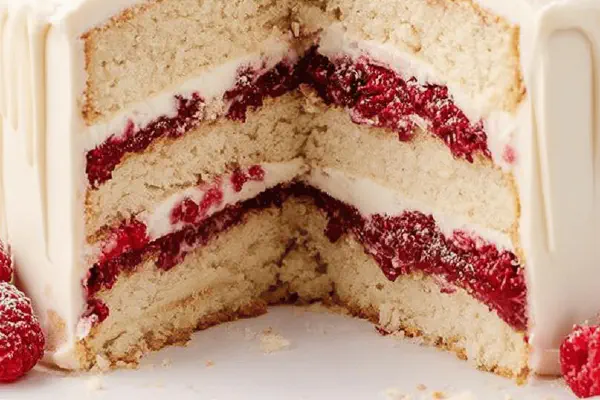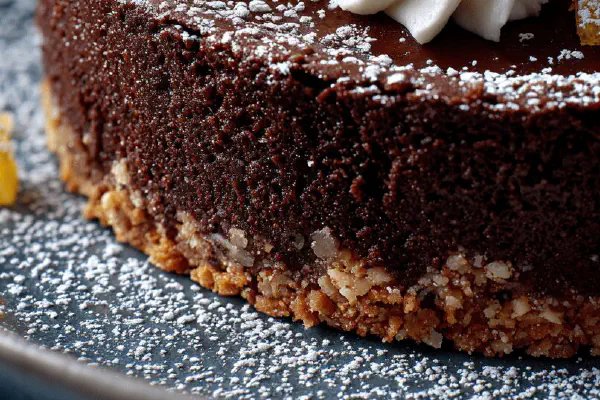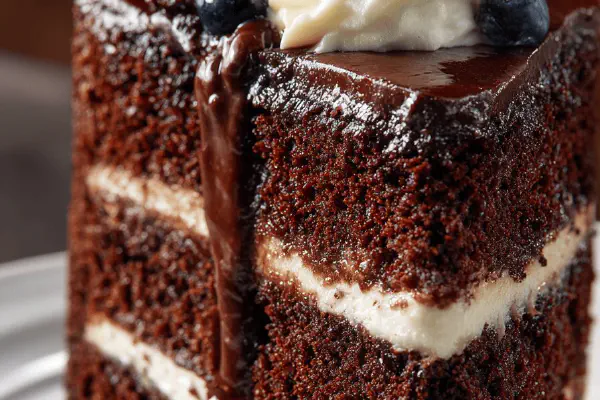Featured Recipe
Chocolate Caramel Buttercream Cake

By Kate
"
Rich chocolate layers combined with a salted caramel buttercream. Uses cake crumb for texture and rustic finish. Adjust flour for density, swap canola for grapeseed oil. Caramel made from scratch but store-bought works. Whisk eggs and sugar well. Buttercream requires patience whipping in butter slowly. Attention to caramel color key. Baking cues over precise minutes. Cake crumb baked crisp adds crunch contrast. Assembly balances tenderness and firmness. Ideal for those who know their way around a kitchen.
"
Prep:
Cook:
Total:
Serves:
16 servings
cake
dessert
baking
chocolate
caramel
Introduction
Start with dense bittersweet chocolate flour blend. Eggs beaten to airy lightness hold structure. Oil keeps crumb moist without complicating flavor—grapeseed instead of canola sharpens profile. Buttermilk acid reacts with baking soda powder, opens crumb pockets. Caramel’s smoky amber color signals that avoided raw sugar edge. Adding cream slowly tempers sugar crystals, yielding satiny sauce, critical for an ungritty buttercream. Butter beaten increments keeps emulsion stable—rush it and it breaks. Crumbs baked and pulsed add crunch layer, offsetting buttercream silk. Orange zest cuts fat heaviness, espresso whispers cocoa’s dark notes. Precision in timing. Temperature vigilance. The subtlety of mastering patience. Every piece counts.
Ingredients
About the ingredients
Flour measured slightly less than typical to lighten texture. Cacao powder sifted removes lumps, ensuring even cocoa distribution. Canola optional; grapeseed adds nuttiness without overpowering. Buttermilk needs to be room temperature to prevent shocking the eggs. Egg yolks chilled improve sauce stability. Sugar caramelized slowly, not rushed—color signals doneness, not watch alone. Butter softened at room temperature but not melted. Salted caramel choice: homemade adds control; quality store-bought saves time. Espresso powder intensifies chocolate without bitterness. Orange zest brightens all-heavy notes, keeps palate interested. Crumbs made from cake domes reduce waste, contribute crisp texture essential for mouthfeel contrast.
Method
Chocolate cake layers
- Oven rack center, preheat 175°C (347°F). Prepare two 20 cm (8 in) springform pans; grease sides, parchment bottom. Flour dust optional for stick-proof but not mandatory.
- Sift flour, cacao, baking soda, baking powder together. Combine dry well to avoid clumps of baking soda.
- In large bowl, whisk eggs with sugar 2.5 min until pale, slightly thickened. Gradually add oil, then vanilla and orange zest. Whisk in espresso powder — amplifies chocolate depth without bitterness.
- Add dry mix in thirds, alternating with buttermilk starting and ending with dry. Fold gently; overmixing toughens crumb. Thick but pourable batter ideal.
- Divide batter evenly, smooth tops. Bounce pans lightly to remove air pockets. Tap-tap-tap.
- Bake 40-50 minutes. Start poking with skewer after 38 minutes. Look for moist crumbs clinging, no raw batter. Sides pull slightly away from pan.
- Cool in pans 15 min, release springs, invert onto wire racks. Flip right side up once cooled 10 min more. Full cooling 90-110 min critical to avoid buttercream melt.
- Trim domes with serrated knife, discard or crumble for texture.
- Spread cake domes thinly on baking sheet, low 150°C (302°F) 12-15 min till dry crust forms with toasted notes. Cool fully, roughly pulse in food processor coarse crumb.
- Whisk yolks lightly, no foam. Prepare caramel: boil sugar and water til amber gold—listen: bubbling deepens, aroma changes. Never stir once boiling.
- Pull off heat, slowly stream half the hot cream carefully to stop hardening. Back on heat, whisk gently, dissolve crystals; add remaining cream. Boil briefly, strain immediately to remove lumps for silky smoothness.
- Temper yolks by whisking in hot caramel gradually. Return to lowest heat, cook stirring with wooden spoon, coat spoon's back with thick custard. Nurse it, don’t rush or curdle.
- Pass through fine sieve to bowl, cool slightly. Cover surface to prevent skin.
- Beat butter on medium until creamy. Pour warm-ish custard in, spoonfuls at a time, beat continuously until glossy, aerated, no lumps. Scrape edges often. If butter cools too much, warm bowl gently to avoid breaking. Rescues: quick microwave bursts or heated spatula warm.
- Add caramel, incorporate thoroughly. Chill 15 min if too soft.
- Split each cake horizontally for four thin layers total. Use a serrated knife or cake leveler.
- Spread 115 ml (just under 1/2 cup) buttercream on three layers individually, sprinkle 50 ml (scant 1/4 cup) dry crumbs atop each layer, press lightly to set texture.
- Stack layers neatly, press gently, ensures stability.
- Mix remaining crumbs with leftover buttercream; use to crumb coat entire cake. Smooth somewhere between rustic and perfected.
- Chill assembled cake 25-35 min; firmness aids apply and control finish layer.
- Spread reserved salted caramel atop, encouraging slow drip down sides. Use offset spatula for controlled pour.
- Garnish tips: flaky sea salt scattered over caramel elevates sweet-salty contrast. Thin chocolate shards, toasted almonds for crunch are optional.
- Serve shortly after chilling, not frozen, to preserve richness.
- ==Notes and tips==
- Flour substitution: cake flour plus 2 tbsp. cornstarch for lighter crumb. Cold ingredients vs room temp adjust batter viscosity.
- Caramel color crucial: undercooked—grainy and bland. Overcooked—bitter burnt. The golden amber stage carries deep caramel flavor.
- Butter temp is key: too cold resists whipping, too warm melts, causing curdled buttercream. Bring butter out 15-20 min, soft but intact.
- Cake domes trimmed for flat stack and crumb retrieval. Re-baking crumbs removes freshness, crisp texture essential.
- Don't rush cooling; warm cakes wreck buttercream structure causing slide-off or melt spots.
- If buttercream breaks, chill few minutes, whisk slowly. Fat phase switching; patience wins here.
- Espresso powder and orange zest optional but recommended for depth and brightness, subtle aromatics cut richness.
- Use metal or glass bowl for buttercream; plastic can retain grease residue affecting aeration.
- Parchment extends cake life and aids unmolding.
- Humidity and altitude may increase baking times slightly.
- Sharper serrated blade yields neater layers, less crumb drag.
- To store: fridge wrapped tightly, bring to room temp 1 hour before serving for best palate.
Salted caramel buttercream
Assembly
Technique Tips
Oven temperature and rack positioning influence even baking; mid-rack avoids burnt bottom or pale tops. Grease pans and parchment liner prevents sticking while allowing air flow. Eggs whisked until pale and thick trap air, essential lift without chemical reliance. Folding dry alternated with wet creates emulsified batter, overmixing dries cake. Baking skewer must come out with moist crumbs, not wet batter. Cooling time paramount; warm cakes ruin buttercream set. Caramel requires focused attention; bubbling sound changes from vigorous to rhythmic indicate precise caramel stage. Gradually adding cream tempers caramel, prevents crystallization. Tempered yolks combined gradually build custard strength. Butter beaten incrementally integrates fats, creating stable, creamy buttercream. Crumbs baked again crisp, pulsed coarse—no fine powder which dulls texture. Layering uses crumb to separate dense layers for better bite. Crumb coat chills to firm finish coat. Caramel topping applied when buttercream firm to avoid running. Use spatula for precise finish, rustic over slick modern. Patience: chilling phases enforce structure; skip at risk of collapsed cakes or slipping layers.
Chef's Notes
- 💡 Temperature control is key. Eggs room temperature, butter not too cold. Gradual mixing avoids lumps. Cream should warm, not cool for best buttercream.
- 💡 Get that cake crumb right. Bake cake domes until they have crisp texture. Pulse crumbs coarse; no fine powder for crunch contrast. Dry crust on crumbs adds layers.
- 💡 Caramel demands attention. Boil sugar gently; stir before, not during. Listen for bubbling; the sound changes as color shifts. Amber means deep flavor.
- 💡 Must keep cooling times in mind. Warm cakes ruin buttercream. Full cool needed before frosting. Watch for buttercream breaking; if too cold, it won’t whip.
- 💡 Use flour substitutions if you need lighter. Cake flour plus cornstarch alternative. Buttermilk helps moisture and fluff, generates needed acid reactions.
Kitchen Wisdom
How do I avoid dry cake?
Don't overmix batter; gently fold in dry and wet. Watch cooling times; warm cakes wreck buttercream structure.
What if my buttercream is too soft?
Chill briefly, firm up buttercream. If too warm, butter has broken. Quick heat; careful mix back.
Can I substitute ingredients?
Yes! Grapeseed oil instead of canola. Use sour cream in place of buttermilk. Experiment but balance ratios.
What's the best way to store the cake?
Fridge wraps tightly for freshness. Bring to room temp before serving. Avoid cold cakes ruining texture.



